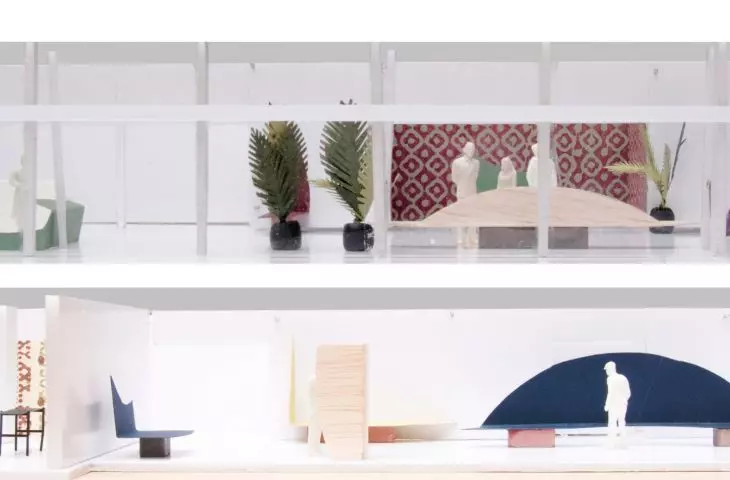If an architectural exhibition is to be about the Anthropocene, its design must also respond to the challenges of the climate crisis. Centrala has prepared a concept for an exhibition for the National Institute of Architecture and Urbanism, the elements of which will be created from materials recovered from the construction of the MSN. The project was selected in a closed competition, and one of the selection criteria was to find the best response to the climate challenges.
bagel for the future
Exhibition design
photo: Centrala / NIAiU
The structure of the exhibition's narrative was based by the curators on the diagram of the economics of the bagel. This is an economic system developed by Kate Raworth, in which people's activities are limited by an ecological ceiling and a social base. Within the framework of ecological issues, the exhibition will present biodiversity, pollution, water, land transformation, landscape and climate. The social base will tell the story of health, education, networks, biological and social needs and housing.
looking to the future
Exhibition design
Photo: Headquarters / NIAiU
The exhibition will feature both existing and historic buildings responding to particular challenges of the last century, as well as speculative projects showing how architecture can respond to current challenges and problems. Teams made up of people working in the fields of architecture, landscape architecture and design have been invited to create them. Among the authors of the installations will be Miastopracownia, NAS-DRA, Centrala, Marta Tomasiak, Kasper Jakubowski, Dorota Kabała, Krzysztof Janas and Jan Szeliga.
symbolic space
The diagram of a bagel, structuring the exhibition narrative, in spatial terms symbolizes a torus, which, cut into slices - rings, gave shape to the exhibition arrangement. Viewers become familiar with the individual ring slices, and the image of continuity and interdependence of the processes presented in the exhibition can compose themselves in their imagination thanks to the characteristic bent edges. Organizing imagination for the future is the postulate of the exhibition.
Exhibition design
photo: Central / NIAiU
The sizable scale of the rings corresponds to the scale of the pavilion's architecture - it is the scale that causes their deformation, i.e. dissection, bending. The arrangement created in this way also frames the visitors themselves as participants in the processes presented at the exhibition. The components of the ring on the square will be configurable differently to suit your needs. It will be dominated by sections that can serve as seats. Others will serve for selected exhibits or will be dedicated to plant and animal visitors to the exhibition.
exhibition from waste
photo by Marta Ejsmont / MSN
The idea of creating displays on a large, architectural scale is supported by the possibility of using recycled materials. Next door, on Parade Square, construction is underway on the new headquarters of the Museum of Modern Art, which declares its willingness to donate them.
photo by Marta Ejsmont / MSN
The displays will be built from various types of wood-based panels , which are currently used as protective materials for pillars, formwork for temporary assembly platforms, formwork elements or packaging for finishing materials. Proximity of materials is key in this idea. However, it requires organizing a temporary workshop in the plaza in front of the pavilion, where the acquired materials will be processed. Protected by an openwork fence, the open-air workshop will itself expose the specifics of designing from demolition materials. It's a group skill, and requires a multi-skilled team: assemblers, designers, curators, who will jointly assess the material, conditions and economy of effort. Processing translates not only into material consumption, but also into labor, simultaneously physical and conceptual, always a team effort. Often to consume less material requires more labor. Centrakla proposes arranging the exhibition as a process to show architectural activity in line with the spirit of circular design.
The exhibition is planned for September 2022 at the Zodiac Warsaw Architecture Pavilion and spring 2023 in Wroclaw.
Curators: Kacper Kępiński, Adrian Krężlik
Organizer: National Institute of Architecture and Urbanism
Concept authors: Centrala - Simone De Iacobis, Malgorzata Kuciewicz
competition
The design of the exhibition arrangement was selected in a closed architectural competition organized by NIAiU. One of the main criteria for evaluating the works was the best response to the challenges of the climate crisis and reducing the negative impact of the exhibition's production on the environment. In addition to Centrala, the competition was attended by:
A-A Collective
Marcin Kwietowicz
We Design Dorota Kabała
Atelier Starzak Strebicki






















































